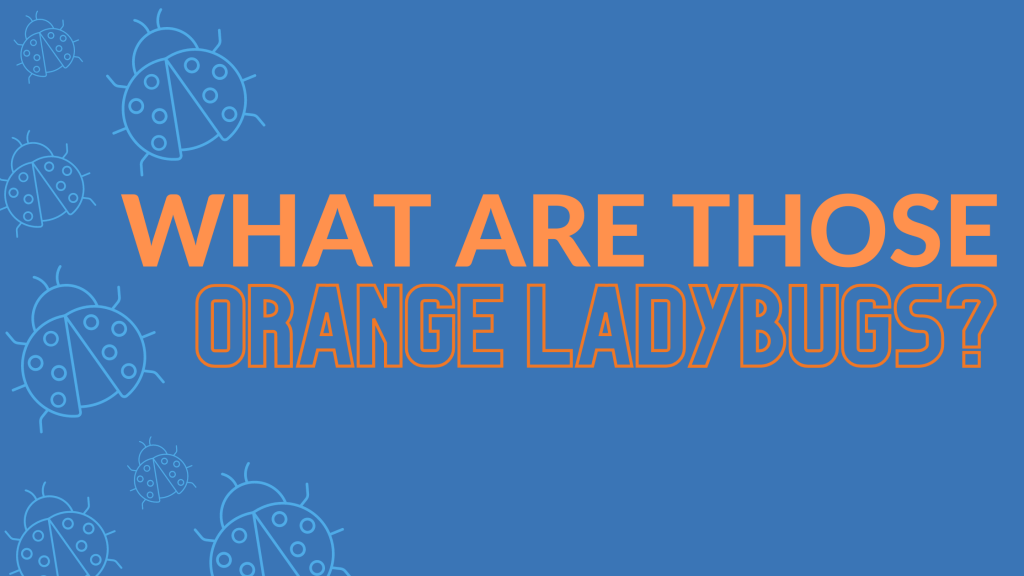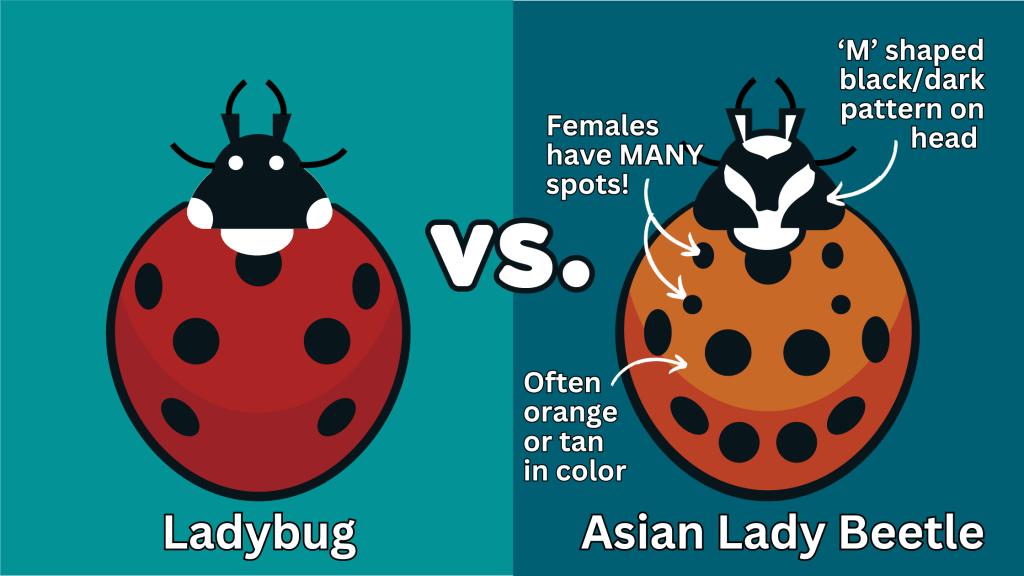What are those orange ladybugs in Ohio?

As the weather’s gotten cooler, you may have noticed an influx of little orange ladybugs crawling around inside your home. It’s easy to dismiss these tiny invaders as nothing more than regular ol’ ladybugs trying to find warmth indoors. Unfortunately those little orange ladybugs are actually a major nuisance pest across Ohio and the rest of the United States — and they’re not even really ladybugs!
Read more to learn what they really are and why you probably don’t want them around your home.
So what are those orange ladybugs?
The orange ladybugs you see around Ohio are actually Asian lady beetles. Like stink bugs, these beetles aren’t a native species to our state. As their name suggests, they’re originally from Asia (often found around China, Russia, Korea, and Japan).
They were initially introduced throughout the U.S. in the 1960s to the 1990s for aphid and mite population control. Unfortunately, the efforts to utilize these beetles for natural pest control against other plant-killing pests backfired. The Asian lady beetle population quickly became invasive because they lack many natural predators here.
What do Asian Lady Beetles look like?
Adult Asian Lady Beetles are small, oval shaped insects that often resemble orange ladybugs.
Asian lady beetles are usually identified by their bright orange color but they do vary in coloration from tan to red. Female Asian lady beetles typically have multiple spots across their wing covers while those with few to no spots tend to be male. Asian lady beetles also have a distinguishable small, dark “W” or “M” shaped marking on the white area behind their head.

Asian lady beetle eggs are oval shaped, yellow in color. The eggs are usually laid in large clusters of about twenty, which are often found on the undersides of leaves.
Are Orange Ladybugs dangerous? Can they bite?
Orange ladybugs (Asian lady beetles) can bite!
However, the good news is that you can barely feel the bite, if at all. The bites of Asian lady beetles aren’t venomous to humans. They also don’t sting and do not carry disease. Very rarely does an Asian lady beetle bite hard enough to even break human skin. If that does happen it will likely only cause minor, short-term discomfort. There are, of course, cases of orange ladybug bites causing allergic reactions in some people – but that’s an even rarer occurrence. Typically Asian lady beetles accidentally bite humans when they’re searching for moisture or food, not as a form of self-defense to you picking them up!
What you’re more apt to experience when dealing with orange ladybugs is a nasty smell when you handle or squish them. The smell isn’t as bad as smashing a stink bug but it’s still noticeable. When handling, they may secrete a stinky yellowish liquid from the joints of their legs. While harmless to humans, this substance can stain light-colored surfaces so be mindful of squishing an Asian lady beetle against a white or beige painted wall or door!
Are orange ladybugs harmful to dogs?
The short answer is – technically, yes
There have been rare cases where dogs have gone to the vet for having a bunch of Asian lady beetles stuck to the tops of the roofs (palates) of their mouths, similar to us getting the hull of a popcorn kernel stuck in our mouth. Because of the small size and round shape of the beetles, it can be difficult for a dog’s tongue to remove them (unlike us they can’t just brush their teeth or use a toothpick).
Like with other bugs and pests, Asian lady beetles usually only become a problem when the pet eats too many at once. Animals are curious and sometimes have a tendency to eat things they shouldn’t. If you notice a lot of Asian lady beetles around your home and your dog is interested in them, you may want to peek into your pet’s mouth to check that the beetles aren’t getting lodged to the palate. Additionally, keep an eye on your dog for other indicators that something is wrong, like excessive drooling or reluctance to eat their normal food, and talk to your vet immediately!
Why are there so many orange lady bugs in my home all of a sudden??
In autumn, adult Asian lady beetles leave their summer feeding sites to find shelter from the approaching cold of winter. Unfortunately for Ohioans, the shelter these beetles find is usually within our homes and other buildings around our nice, warm houses. Swarms of orange lady beetles typically fly to buildings between late September through early November or December, depending on weather conditions.
Once the beetles find a suitable surface to land on, they’ll seek out crevices and other protected spaces to spend their winter in hibernation. You’ll often find them in attics, wall cavities that have outside access, cracks around windows and door frames, behind exterior siding, and within other cracks and openings around your home that need to be sealed or caulked.
While they’re relatively harmless in general, the problem with Asian lady beetles arises the following spring when the beetles become active again. As they awaken, the beetles are drawn to the closest light source they can find, in search of the sun that will guide them back outside to feed. Unfortunately, they can get a little disoriented and the closest light source could be your indoor light fixtures. This can result in dozens of orange beetles swarming around the inside of your home, chaotically looking for a way to escape and causing you distress as you try and get them back outside!
What attracts Asian Lady Beetles to your home
Illuminated Surfaces
Asian lady beetles are attracted to illuminated surfaces and will often congregate on sunny, southwest facing sides of buildings that are lit by the afternoon sun.
Contrasting Light-Dark Features
Contrasting light-dark features on the outsides of homes and buildings also tend to attract lady beetles. This could be dark doors and shutters against a light colored home or light-colored trim or gutters on a darker painted home.
Homes Near Fields or Woods
Asian lady beetles tend to feed in yards, forest, and fields so when it comes time for them to migrate, they’re more likely to invade homes that are already close to their feeding sites.
Is an Asian Lady Beetle infestation something to worry about?
Asian lady beetles are considered a general nuisance pest to Ohio homeowners, espeically since they are capable of gathering inside homes in large numbers. When agitated or disturbed, they can release foul-smelling yellowish liquid – which can stain drapes, upholstery, other fabrics and light colored walls. While they typically don’t do much worst damage, they can definitely be annoying especially during the spring when ALL of them emerge!
How to get rid of orange ladybugs
There are a few methods to get rid of Asian lady beetles. One thing to keep in mind is that it definitely helps to be as proactive as possible to keep them outside before they even become an indoor issue.
Here are some proactive methods to help keep Asian lady beetles out of your home:
- Asian lady beetles can squeeze through cracks and gaps as tiny as 1/8″ in width so it’s important to seal gaps, cracks and all other crevices around your home where the beetles can enter with a sealant like silicone caulk. Check around the siding, doors and door seals, windows, chimneys, and vents. Double-check other potential openings that may lead into your home, too, such as from utility wires and pipes.
- Make sure to have a fine mesh on your windows, doors, and exhaust vents to prevent beetles from being able to enter through these openings. Repair or replace damaged door and window screens, as well.
- If Asian lady beetles are a yearly problem around your home, you may want to consider an exterior barrier treatment, like a Body-Guard Plan from go2pros. A professional pest control technician can safely apply these treatments around your home to help repel Asian lady beetles and pests like ants, termites, wasps, hornets, mice, mosquitoes, and other critters.
There are also a few things to do if you notice they’ve already found their way into your home, too:
- Use a broom to sweep the insects into a dustpan or other container to relocate them back outside
- Alternatively, to avoid squishing the insects and possibly causing stains or having them release their foul odor, you can vacuum them up. Release the vacuumed insects back outside when you’re done.
- Use UV or light traps in areas around your home that stay relatively dark and are likely to entice Asian lady beetles – such as in attics or areas around your home that don’t get a lot of foot traffic.
Do you have a problem with Asian lady beetles around your home? Contact our pest control team for more information on how to prevent and treat these annoying pests.
